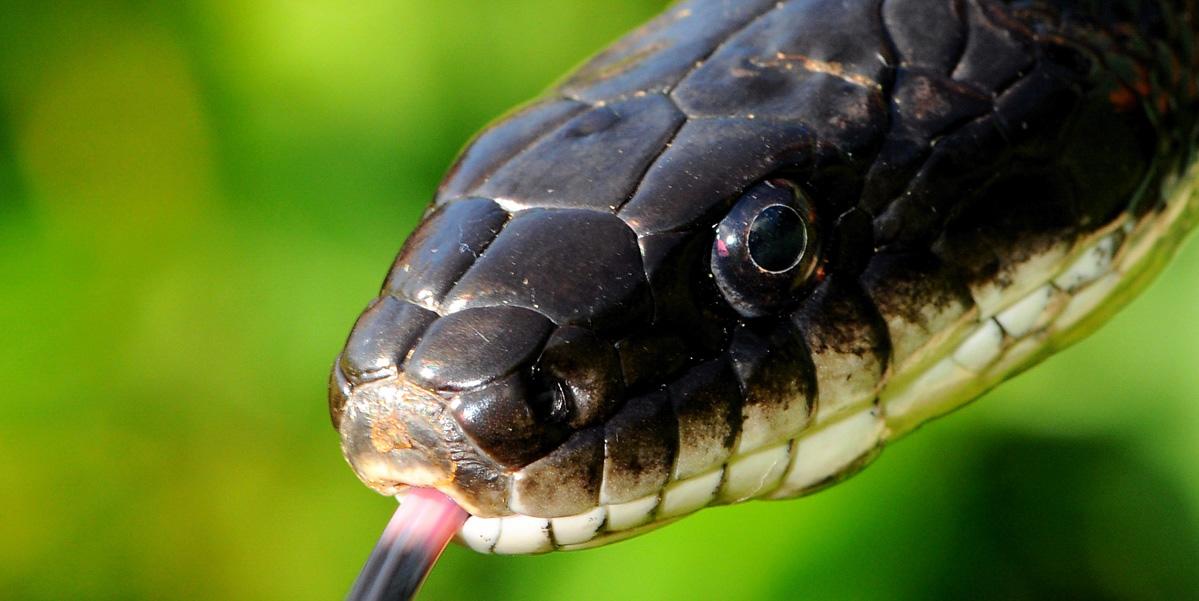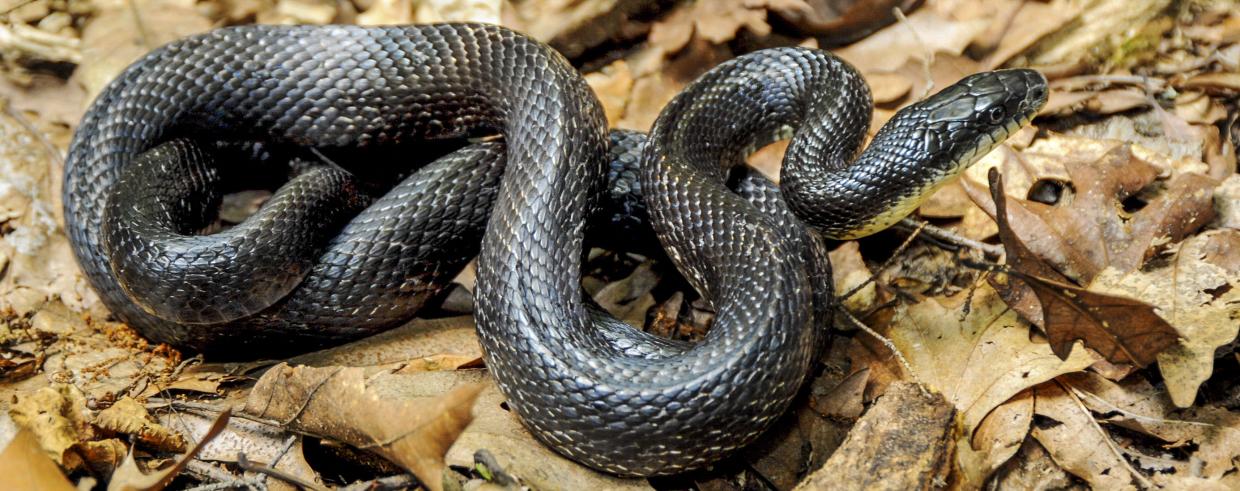Fast facts
Common name: Eastern ratsnake
Scientific name: Pantherophis alleghaniensis
Range in MA: Franklin, Hampden, Hampshire, and Worcester counties.
Conservation status: Listed as endangered in Massachusetts
Fun fact: Can climb sheer cliffs
Similar species: Other snakes with “saddlemark” patterns: North American racers and milk snakes
Identification tips: Look for keeled scales and notice behavior. Racers are more alert and quick to flee when warm, while ratsnakes are more lethargic. Adult ratsnakes are much more heavy-bodied than racers.
Description
Eastern ratsnakes are large, black, and shiny. Some adults also have traces of white patterning, which is caused by pigmented skin exposed between rows of scales. Their chins and throats are white and un-patterned. Their undersides are mottled and become uniformly gray towards the tail. The length of this mottled pattern varies by individual. Their eyes have black pupils, which are sometimes surrounded by distinctly white margins. Body scales are weakly keeled. Ratsnakes sometimes vibrate their tails when alarmed, like timber rattlesnakes, but they lack an actual rattle.
Juvenile ratsnakes are pale gray with a diamond pattern. Their pupils are distinct with a prominent white margin. Their undersides are white, similar to adults.
If you see one
Because they are endangered in Massachusetts, please maintain a safe, respectful distance. Avoid trying to handle or otherwise disturb them.
To help with conservation efforts, please submit your observations with us. Either:
- create an account in the Heritage Hub, or
- complete and mail a Rare Animal Observation Form for one-time observations.
Your reports provide critical information that informs future habitat management and wildlife conservation for future generations.
Habitat
Massachusetts populations are mainly restricted by the availability of hibernating sites in areas of the Connecticut River Valley, southern Worcester County, and Bristol County. New England is the northern limit of their range, and their hibernacula (areas where snakes overwinter) are in areas with southern exposure that receive maximum thermal benefit from the sun in winter and provide basking areas in early spring and late fall.
Eastern ratsnakes may share hibernacula with other snakes, including racers, copperheads, and timber rattlesnakes. Other than their special needs for hibernation, eastern ratsnakes live in a variety of forests, as well as in adjacent fields, thickets, and other habitats that support populations of their prey species.
Life history
Eastern ratsnakes emerge from hibernacula in spring and disperse into adjacent woodlands to mate and feed. They can climb trees and can enter rodent holes in the ground to find food during spring and early summer. Research suggests they do not venture more than one mile from their overwintering locations. They lay 8–12 eggs in June, in piles of decaying leaves and other rotting vegetation, stumps, or hollow logs or trees. Foot-long young hatch in August or September. They can live to be at least 20 years old.
Ratsnake diets consist mainly of small mammals like deer mice, voles, eastern chipmunks, squirrels, and small cottontails. They can also eat birds, amphibians, and other reptiles. Eastern ratsnakes are constrictors, squeezing to subdue or kill prey. Their own predators include mink, large carnivores, and large birds of prey.
Due to their relatively docile nature and large size, these snakes are popular in the pet trade. In Massachusetts, it is illegal to capture a wild eastern ratsnake, and it is illegal to possess one from any other source, including from out of state.
Management and conservation
Populations are threatened by habitat alteration, especially residential houses built on ridgelines and rocky outcrops. They are also negatively impacted by illegal collecting for the pet trade, roadway collisions, and the succession of open agricultural land to second-growth forest, which leads to more homogeneous, less biologically diverse upland habitat.
Continued research is needed to locate and assess habitat and denning locations. Vehicular traffic should be minimized within about 1km of den sites. Small-scale agriculture and forestry may be beneficial, if they can help create and maintain edge habitats.

